Technology (Innovations for Education)
Setting Goals in a Digital Age
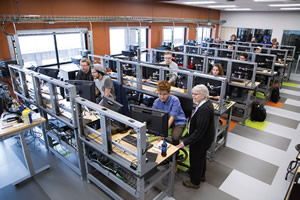
PHOTO © GREG LEBRICK, GATEWAY TECHNICAL COLLEGE
It can be a chicken-or-egg conundrum. Do you take a look at your technology investment and ask where it can take you, or do you decide where you want to go and invest in technology to get you there? The first approach can take you somewhere, with hopefully satisfactory results. The second approach, requiring a little up-front goal setting, can make a real difference in advancing your education program. Take a look at these two examples.
Gateway Technical College
Administrators at Gateway Technical College (GTC) in Kenosha, WI, have worked diligently through the years to meet a goal of providing a robust educational program via video conferencing. To date, GTC has video conferencing equipment on all five of its campuses and in nine partner high schools.
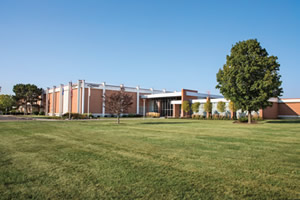
PHOTO © GREG LEBRICK, GATEWAY TECHNICAL COLLEGE
Kenosha campus, Kenosha, WI
“In its first iteration,” says Jeff Robshaw, GTC’s vice president for learning innovation and chief information officer, “the program was a partnership among various high schools in the district and a third-party governing agency. Around 2010, the third-party agency experienced personnel changes, and we opted to take control. We created a Virtual Academic Network (VAN).”
Here’s how it works. If a student in Elkhorn wants to take a class that’s only offered at the Racine campus, s/he can take the course via video conferencing. This works for large and small groups—even as small as five people. The high school partnership has two facets. First, GTC delivers college classes to students through distance learning, allowing students to earn college credits while still in high school. Second, for a small fee, partner high schools use the equipment to deliver distance learning courses to other high schools.
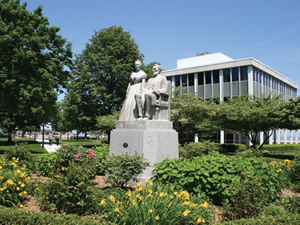
PHOTO © GREG LEBRICK, GATEWAY TECHNICAL COLLEGE
Racine campus, Elkhorn, WI
“In this way, larger districts share their resources with smaller districts,” Robshaw indicates, “such as offering a German class.”
With the equipment, administrators are able to offer classes even when class sizes are small. “In an older model,” says Robshaw, “if we didn’t have 30 students on one campus to take a class, we couldn’t offer it. Now, we can run a class with, say, five students in Racine, five in Kenosha, and five in Elkhorn. Because we’re all about access and opportunity, it has been a great tool for providing a variety of offerings to students when they want them.”
Through the years, GTC administrators have struggled in terms of bandwidth with the high schools. “It wasn’t as affordable as it is today,” says Jeffrey Zellmer, Learning Innovation Division infrastructure technician. “And the way their networks were configured with firewalls gave us some issues. We recommended they use another circuit and add PBX devices. Adding codecs has made managing it easier, and it has streamlined things for them as well.”
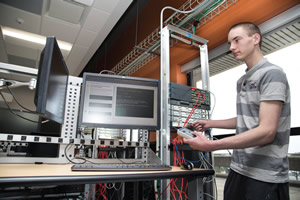
PHOTO © GREG LEBRICK, GATEWAY TECHNICAL COLLEGE
Another hurdle with which the college has dealt has been vendors offering one-on-one video conferencing models. “With video conferencing, it’s becoming a model where you click on a link and join a one-on-one conference immediately,” Robshaw observes. “Vendors may have overlooked the considerations that the education industry has, such as the one-to-many experience. It has created numerous issues for us in terms of organizing and scheduling classes.”
Yet there’s a benefit to the one-on-one link. Zellmer indicates that they’re hoping to use it via their Blackboard learning management system for students to have one-on-one meetings with their professors during open office hours without leaving their homes. Also in the future, administrators plan to offer mobile video conferencing technology at an advanced center, such as engineering or nursing, with a mobile camera and a facilitator. “We hope to have an instructor interacting live with students and guiding them with real world experts to provide a richer educational experience,” says Robshaw.
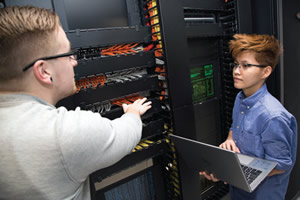
PHOTO © GREG LEBRICK, GATEWAY TECHNICAL COLLEGE
For the immediate future, the team is researching vendors and their services, contemplating a change. “We have to always be assessing our technology options because things change rapidly,” Robshaw says. “It’s important to be ahead of the changes, as opposed to reacting to them.”
Benedictine University
Administrators at Benedictine University, a private university 30 minutes from Chicago in Lisle, IL, have a goal of building a better world through business. One example of their efforts is the Daniel L. Goodwin College of Business, a 125,000-square-foot facility that opened in October 2015, with a construction cost of $40 million.
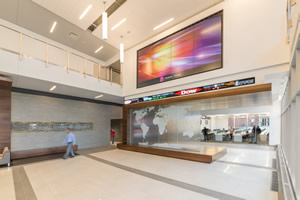
PHOTO © JAMES STEINKAMP PHOTOGRAPHY, COURTESY OF DLR GROUP ARCHITECTS/ENGINEERSE
LET’S GET DOWN TO BUSINESS. The Daniel L. Goodwin College of Business at Benedictine University in Lisle, IL, is home to the university’s graduate and undergraduate business programs. The state-of-the-art facility includes a 6,000-squarefoot global hall with live digital stock ticker and a billboard-sized, multi-screen high-definition media wall; a 40-seat state of the art Bloomberg Trading Lab, and LED touch-screen displays for checking class schedules, location, and event information. Technology-rich and interactive, the design intent for the facility was to deliver education with transparency and provide access to learning for the entire student body.
Visitors step into a 6,000-square-foot “Global Hall” entrance area that includes an etched glass globe, digital stock ticker, and billboard-sized high-definition media wall by Planar that broadcasts business news from across the world.
“The beauty of the media wall,” says Kate Yurko, AIA, LEED-AP, NCARB, higher education leader and principal with DLR Group, the international firm that designed the building, “is in branding. The display can be changed depending on how the building is used, and it is used for both public and private events.”
Further inside is a 620-seat auditorium with tiered seating focused toward a material-rich stage and surround that can be used for guest speakers, digital media experiences, or instructional lectures. “This space includes a huge projection screen that has amazing resolution,” Yurko says. “Plus, there are monitors suspended from the ceiling as the seating moves back so everyone is able to see the display. We were able to position the monitors to avoid blocking anyone’s line of sight.”
For the business students, a state-of-the-art Bloomberg Trading Lab provides access to peer-ranked investment simulations, public and private company accounting and international economic data, and other real-time financial information. This technology gives students access to the same information platform used by key decision-makers in business, finance, and government and helps to educate students how to analyze financial markets, assess economic scenarios, and interpret key news developments impacting the global economy.
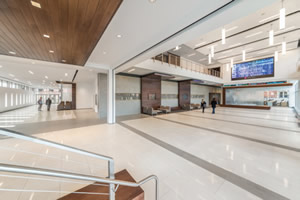
PHOTO © JAMES STEINKAMP PHOTOGRAPHY, COURTESY OF DLR GROUP ARCHITECTS/ENGINEERSE
The entire building is interactive. Interior spaces are strategically designed to promote flexibility, scalability, mobility, and adaptability, such as a 250-seat open flexible seminar room on the top floor that partners up to the balcony/deck overlooking campus. Classrooms are designed with no limitations, and collaboration flows through the air media system, allowing every student to connect and share his/her work digitally and wirelessly.
Next on the college’s docket toward meeting goals is completing a master plan and using program needs to complete an unfinished portion of the building.
What are your goals for delivering education and meeting students’ needs? How are you going to use technology to help you meet those goals?
GTC HAS THE EQUIPMENT
Here’s what GTC administrators have to support their video conferencing education program.
1. Two video conferencing Multipoint Control Unit(s) with 25 ports each. These devices allow several video conferencing codecs to conference together. For example, five simultaneously occurring classes with five locations each would use 25 ports on an MCU.
2. Two video conferencing recorders. The recorders allow video conferencing codecs to record camera/content near or far, all video conferencing connections, or local source video/content when codec is not in a conference.
3. One manager/scheduler. This server-based application is able to show the real-time status of all video codecs registered to it and can schedule connections between codecs, MCU and video recorders.
4. A typical video conferencing room contained the following: one video codec, one wired microphone, two cameras (one facing front of room and one facing students), one multimedia switcher/scaler (for switching content sources between document camera, local PC or laptop), and two projectors/screens (one facing front of the room and one facing the back).
5. A typical portable wheeled cart contains the following: one video codec, one wired microphone, one camera, and one flat panel display (55 to 80 inches).
6. There are 65 video conferencing codecs: 50 at GTC campuses and 15 at eight VANguard High School locations.
This article originally appeared in the College Planning & Management March 2018 issue of Spaces4Learning.